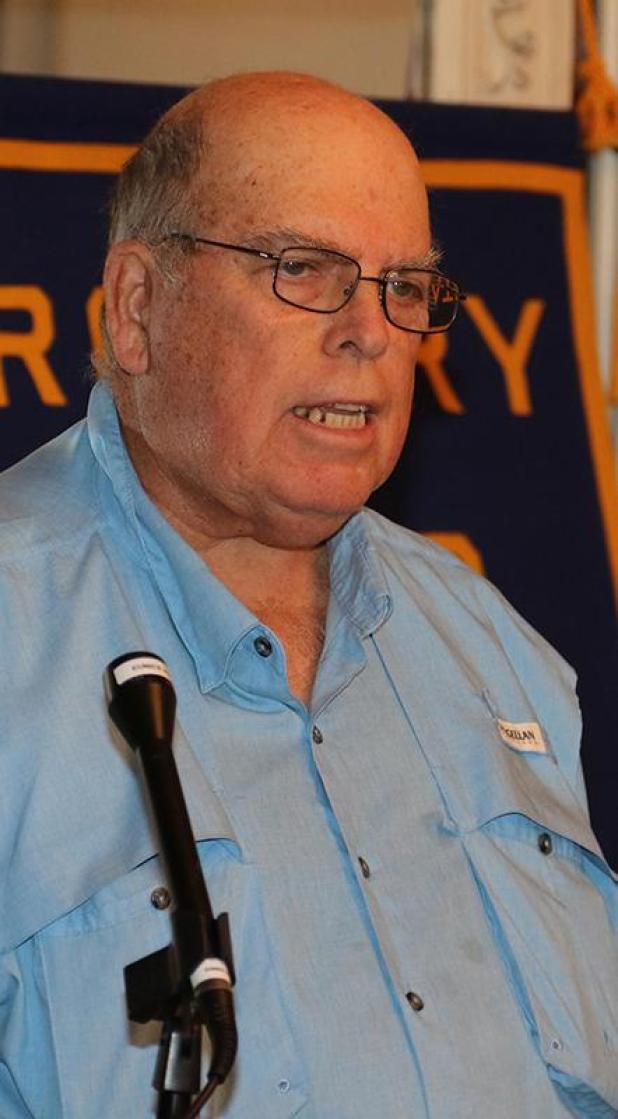
(Photo by Harlan Kirgan)
Dr. Malcolm Vidrine speaks about the Cajun Prairie to the Eunice Rotary Club last Wednesday.
Biologist makes case to bring back the Cajun Prairie
Dr. Malcolm Vidrine made the case for “rewilding” thousands of acres in Acadiana as part of slowing or stopping climate change
“It turns out our prairies are the most efficient and effective habitats to help fight climate change and to slow the current extinction events where life on earth is literally dying out,” he said to Eunice Rotarians on Wednesday.
There are about 3,000 acres of prairie remaining and much of it is degraded, he said. And, much of the prairie is near the coast, which is threatened by the rising sea.
Prairie is the best way to reduce climate change because it stores carbon, he said.
Prairie root systems can go 12 to 15 feet deep, he said. After 15 years the prairie plants in a restored prairie outside Eunice are six to eight feet deep, he said.
Prairie grass across Acadiana had a towering presence at one time. The grass was tall enough that horse riders next to each could only see each other’s heads. The rivers ran clear with sandy bottoms and they were covered with mussel beds 100 years ago.
Now, in many places, the top soil is as shallow as an inch. Farmers feed fertilizer and chemicals on their fields to produce a crop, he said.
The result is toxic runoff leading to the expansion of the Dead Zone and fish kills in the Gulf of Mexico, he said.
Vidrine said he and other scientists are issuing a “clarion call” to rethink the relationship with the land and energy sources or face huge climate change and massive loss of biodiversity.
Vidrine, who retired from LSUE after 35 years teaching biology, and Charles Allen, who also taught at LSUE, are to receive the James Williams Rivers Prize for Louisiana Studies from the Center for Louisiana Studies at the University of Louisiana Lafayette.
In a handout about the award to Rotarians titled “Why,” Vidrine stated, “The answer is two-fold: first, our discovery and research on the Cajun Prairie remnants, and secondly, the global clarion calls by the U. N. agencies for action to moderate eminent climate chaos and curtail the sixth global extinction of Earth’s biodiversity-both largely at the hands of humanity.”
Vidrine stated he and Allen in 1986 discovered a remnant of prairie thought to be extinct in southwest Louisiana.
“We then discovered a dozen more remnants, and we proceeded to visit these remnants weekly to inventory the plants and animals readily observed. We also photographed these remnants-the first photos of this environment. Then we informed the press and notified the media and wrote articles published in local, state, national and international magazines and research journals. We also wrote books and made documentary films,” he stated.
One outcome was the creation of the 10-acre prairie park in Eunice with the help of then Mayor Curtis Joubert.
The park is now owned and operated by the Cajun Prairie Habitat Preservation Society.
“It is now apparent that we need to rewild (restore) as many acres as possible as fast as we can. Our lead goals are 10,000 acres by 2030, 50,000 acres by 2050, and a million acres by 2100. This is the goal for the Cajun Prairie ecosystem in Acadiana. We all have a role to play-this begins in your front yard, where every square inch counts! Our work has been recognized by several people, who nominated us for the awards as part of both recognition of our contribution and a local clarion call to Acadiana,” he stated.
